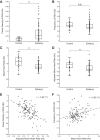Decreased heart rate and enhanced sinus arrhythmia during interictal sleep demonstrate autonomic imbalance in generalized epilepsy
- PMID: 26888110
- PMCID: PMC4869507
- DOI: 10.1152/jn.01120.2015
Decreased heart rate and enhanced sinus arrhythmia during interictal sleep demonstrate autonomic imbalance in generalized epilepsy
Abstract
We hypothesized that epilepsy affects the activity of the autonomic nervous system even in the absence of seizures, which should manifest as differences in heart rate variability (HRV) and cardiac cycle. To test this hypothesis, we investigated ECG traces of 91 children and adolescents with generalized epilepsy and 25 neurologically normal controls during 30 min of stage 2 sleep with interictal or normal EEG. Mean heart rate (HR) and high-frequency HRV corresponding to respiratory sinus arrhythmia (RSA) were quantified and compared. Blood pressure (BP) measurements from physical exams of all subjects were also collected and analyzed. RSA was on average significantly stronger in patients with epilepsy, whereas their mean HR was significantly lower after adjusting for age, body mass index, and sex, consistent with increased parasympathetic tone in these patients. In contrast, diastolic (and systolic) BP at rest was not significantly different, indicating that the sympathetic tone is similar. Remarkably, five additional subjects, initially diagnosed as neurologically normal but with enhanced RSA and lower HR, eventually developed epilepsy, suggesting that increased parasympathetic tone precedes the onset of epilepsy in children. ECG waveforms in epilepsy also displayed significantly longer TP intervals (ventricular diastole) relative to the RR interval. The relative TP interval correlated positively with RSA and negatively with HR, suggesting that these parameters are linked through a common mechanism, which we discuss. Altogether, our results provide evidence for imbalanced autonomic function in generalized epilepsy, which may be a key contributing factor to sudden unexpected death in epilepsy.
Keywords: SUDEP; cardiac cycle; children; heart rate variability; parasympathetic tone.
Copyright © 2016 the American Physiological Society.
Figures




References
-
- Abukonna A, Yu X, Zhang C, Zhang J. Volitional control of the heart rate. Int J Psychophysiol 90: 143–148, 2013. - PubMed
-
- Akinci A, Celiker A, Baykal E, Tezic T. Heart rate variability in diabetic children: sensitivity of the time- and frequency-domain methods. Pediatr Cardiol 14: 140–146, 1993. - PubMed
-
- Annegers JF, Coan SP, Hauser WA, Leestma J, Duffell W, Tarver B. Epilepsy, vagal nerve stimulation by the NCP system, mortality, and sudden, unexpected, unexplained death. Epilepsia 39: 206–212, 1998. - PubMed
-
- Behbahani S, Dabanloo NJ, Nasrabadi AM, Dourado A. Classification of ictal and seizure-free HRV signals with focus on lateralization of epilepsy. Technol Health Care 24: 43–56, 2016. - PubMed
Publication types
MeSH terms
LinkOut - more resources
Full Text Sources
Other Literature Sources

